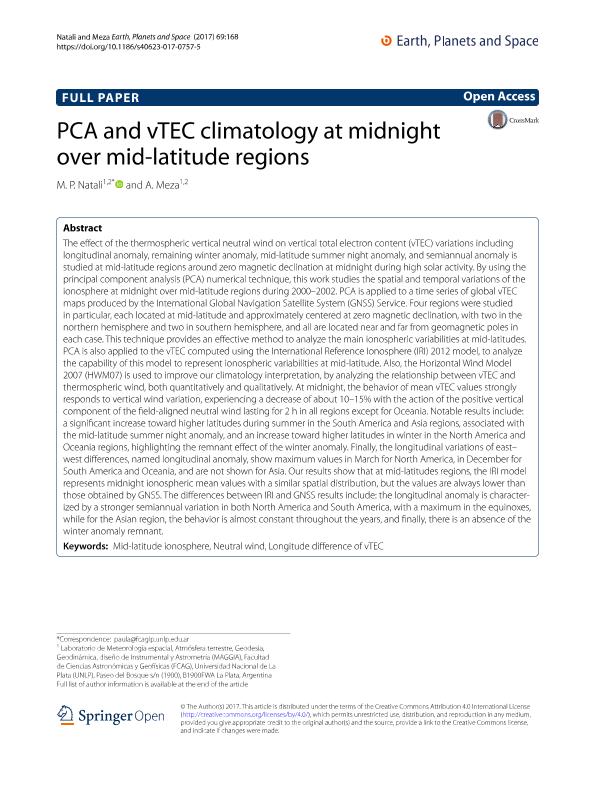Artículo
PCA and vTEC climatology at midnight over mid-latitude regions
Fecha de publicación:
12/2017
Editorial:
Springer
Revista:
Earth Planets And Space
ISSN:
1343-8832
Idioma:
Inglés
Tipo de recurso:
Artículo publicado
Clasificación temática:
Resumen
The effect of the thermospheric vertical neutral wind on vertical total electron content (vTEC) variations including longitudinal anomaly, remaining winter anomaly, mid-latitude summer night anomaly, and semiannual anomaly is studied at mid-latitude regions around zero magnetic declination at midnight during high solar activity. By using the principal component analysis (PCA) numerical technique, this work studies the spatial and temporal variations of the ionosphere at midnight over mid-latitude regions during 2000–2002. PCA is applied to a time series of global vTEC maps produced by the International Global Navigation Satellite System (GNSS) Service. Four regions were studied in particular, each located at mid-latitude and approximately centered at zero magnetic declination, with two in the northern hemisphere and two in southern hemisphere, and all are located near and far from geomagnetic poles in each case. This technique provides an effective method to analyze the main ionospheric variabilities at mid-latitudes. PCA is also applied to the vTEC computed using the International Reference Ionosphere (IRI) 2012 model, to analyze the capability of this model to represent ionospheric variabilities at mid-latitude. Also, the Horizontal Wind Model 2007 (HWM07) is used to improve our climatology interpretation, by analyzing the relationship between vTEC and thermospheric wind, both quantitatively and qualitatively. At midnight, the behavior of mean vTEC values strongly responds to vertical wind variation, experiencing a decrease of about 10–15% with the action of the positive vertical component of the field-aligned neutral wind lasting for 2 h in all regions except for Oceania. Notable results include: a significant increase toward higher latitudes during summer in the South America and Asia regions, associated with the mid-latitude summer night anomaly, and an increase toward higher latitudes in winter in the North America and Oceania regions, highlighting the remnant effect of the winter anomaly. Finally, the longitudinal variations of east–west differences, named longitudinal anomaly, show maximum values in March for North America, in December for South America and Oceania, and are not shown for Asia. Our results show that at mid-latitudes regions, the IRI model represents midnight ionospheric mean values with a similar spatial distribution, but the values are always lower than those obtained by GNSS. The differences between IRI and GNSS results include: the longitudinal anomaly is characterized by a stronger semiannual variation in both North America and South America, with a maximum in the equinoxes, while for the Asian region, the behavior is almost constant throughout the years, and finally, there is an absence of the winter anomaly remnant.
Palabras clave:
Longitude Difference of Vtec
,
Mid-Latitude Ionosphere
,
Neutral Wind
Archivos asociados
Licencia
Identificadores
Colecciones
Articulos(CCT - LA PLATA)
Articulos de CTRO.CIENTIFICO TECNOL.CONICET - LA PLATA
Articulos de CTRO.CIENTIFICO TECNOL.CONICET - LA PLATA
Citación
Natali, Maria Paula; Meza, Amalia Margarita; PCA and vTEC climatology at midnight over mid-latitude regions; Springer; Earth Planets And Space; 69; 1; 12-2017; 1-22
Compartir
Altmétricas




